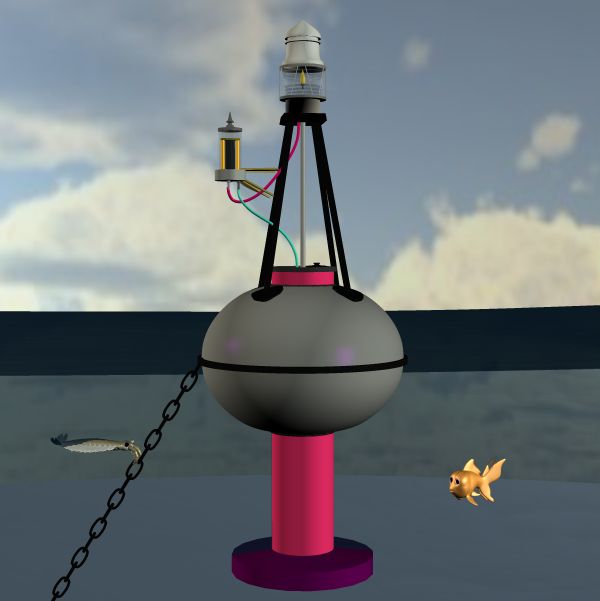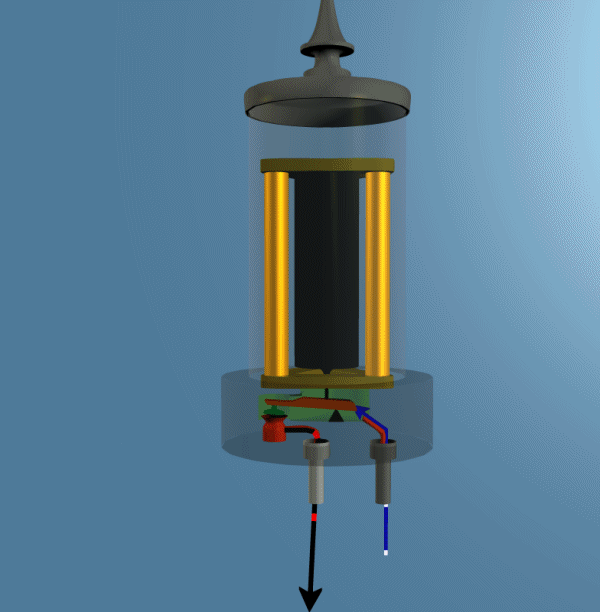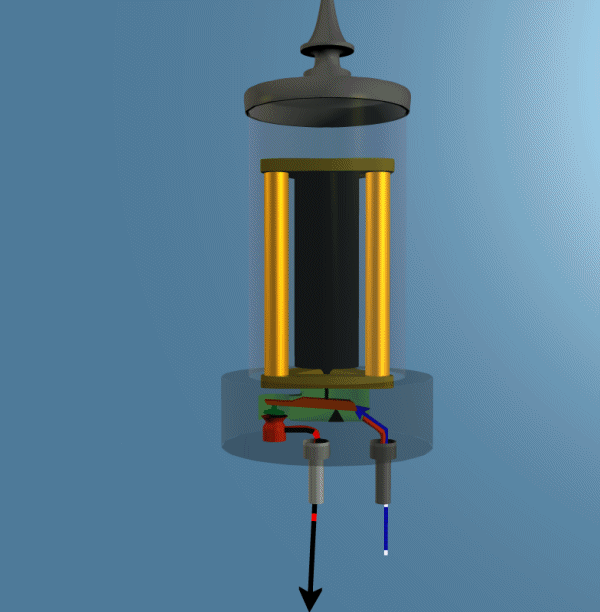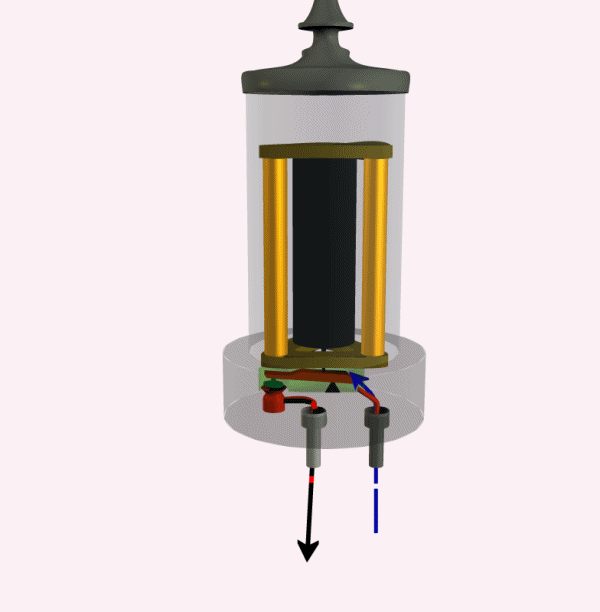Thursday, February 06, 2020
Acetylene world 6, impatience punished
Another story of an inventor who started in resonance with the unique qualities of acetylene, then tried to break out of resonance and paid a price.
Gustaf Dalen started with a uniquely patient mechanism. Not quite as patient as Willson's automatic buoy, which used seawater and gas pressure to create a feedback balance with no mechanics at all.
Dalen's sun valve cleverly used basic properties of materials to turn the gas on and off in response to sunlight. No electronics, no selenium cells, just thermal expansion balanced in a differential setup.
Differential balances were common in the 1800s, especially in British devices. Most diff mechanisms, whether mechanical or fluidic or electronic, resemble the basic balance scale. You can see the plus side and the minus side, and you can see how the fulcrum divides them. The common principle is that the two sides 'float' together on ambient inputs, while responding delicately to differences in the important variable.
Dalen's balance had an unusual form, but the principle was the same.
Here's a Dalen valve mounted on a Willson buoy. The valve controls part of the gas stream to the burner, leaving a small trickle to the lamp at all times to avoid re-igniting.
 The differential was created by gold rods versus black rods. Gold rods reflect sunlight perfectly, black rods absorb sunlight and warm up. Both rods respond to ambient temperature.
The bottom of the gold rods was firmly fastened to the frame. When the gold rods expanded from ambient warmth, they raised the top triangle. (As usual I'm exaggerating all motions for visibility; these expansions were nearly microscopic in reality.)
The differential was created by gold rods versus black rods. Gold rods reflect sunlight perfectly, black rods absorb sunlight and warm up. Both rods respond to ambient temperature.
The bottom of the gold rods was firmly fastened to the frame. When the gold rods expanded from ambient warmth, they raised the top triangle. (As usual I'm exaggerating all motions for visibility; these expansions were nearly microscopic in reality.)
 Here's where the differential comes in. The black rod in the middle is dangling from the top triangle so its still end moves up and down relative to the base when the gold rods expand and contract. The loose or active end of the black rod pushes on the valve, which is normally open.
Under the influence of ambient temperature, all the rods expand together, so the active end of the black rod doesn't move up and down and doesn't push on the valve. The valve is not affected by ambient changes.
Here's where the differential comes in. The black rod in the middle is dangling from the top triangle so its still end moves up and down relative to the base when the gold rods expand and contract. The loose or active end of the black rod pushes on the valve, which is normally open.
Under the influence of ambient temperature, all the rods expand together, so the active end of the black rod doesn't move up and down and doesn't push on the valve. The valve is not affected by ambient changes.
 Now we'll assume ambient is steady and examine the effects of sunlight. Sun doesn't expand the perfectly reflective gold rods. Sun only expands the perfectly absorbent black rod. When the sun is strong, the black rod pushes the valve closed, so the lamp is down to 'pilot' operation. When the sun is dark, the black rod contracts and lets the valve open, sending full gas flow to the lamp.
Now we'll assume ambient is steady and examine the effects of sunlight. Sun doesn't expand the perfectly reflective gold rods. Sun only expands the perfectly absorbent black rod. When the sun is strong, the black rod pushes the valve closed, so the lamp is down to 'pilot' operation. When the sun is dark, the black rod contracts and lets the valve open, sending full gas flow to the lamp.
 This action isn't as perfectly patient as the Willson automatic feed, because it does involve mechanisms. But it's powered solely by the sun, with no extra assistance from clockwork or electricity.
What happens when the sun valve is closed? Does the acetylene pressure build up and require a safety valve? No, Willson takes care of this automatically as well. When the gas pressure above the water builds up, it pushes the water down in the chamber, exposing less of the carbide to the water and slowing the reaction. When the sun valve opens, the pressure above the water decreases, the water rises a bit, starting more carbide reactions.
Dalen made the same mistake as Willson, abandoning the patient world of low-pressure self-motivating acetylene. Dalen started working with high pressure gases, both acetylene and natural gas. While experimenting with high pressure, he was burned and blinded. He continued inventing and managing AGA, which became famous for the AGA cooker.
= = = = =
Time to keep track of the links on the subject...
Auto accessories, led me into the subject
Intro to subject
Just a comment on Edison
Farm usage and a stove
Lighthouse
Army signal lantern
Willson automatic buoy
Dalen automatic sun valve
The last acetylene lighthouse
This action isn't as perfectly patient as the Willson automatic feed, because it does involve mechanisms. But it's powered solely by the sun, with no extra assistance from clockwork or electricity.
What happens when the sun valve is closed? Does the acetylene pressure build up and require a safety valve? No, Willson takes care of this automatically as well. When the gas pressure above the water builds up, it pushes the water down in the chamber, exposing less of the carbide to the water and slowing the reaction. When the sun valve opens, the pressure above the water decreases, the water rises a bit, starting more carbide reactions.
Dalen made the same mistake as Willson, abandoning the patient world of low-pressure self-motivating acetylene. Dalen started working with high pressure gases, both acetylene and natural gas. While experimenting with high pressure, he was burned and blinded. He continued inventing and managing AGA, which became famous for the AGA cooker.
= = = = =
Time to keep track of the links on the subject...
Auto accessories, led me into the subject
Intro to subject
Just a comment on Edison
Farm usage and a stove
Lighthouse
Army signal lantern
Willson automatic buoy
Dalen automatic sun valve
The last acetylene lighthouse
 The differential was created by gold rods versus black rods. Gold rods reflect sunlight perfectly, black rods absorb sunlight and warm up. Both rods respond to ambient temperature.
The bottom of the gold rods was firmly fastened to the frame. When the gold rods expanded from ambient warmth, they raised the top triangle. (As usual I'm exaggerating all motions for visibility; these expansions were nearly microscopic in reality.)
The differential was created by gold rods versus black rods. Gold rods reflect sunlight perfectly, black rods absorb sunlight and warm up. Both rods respond to ambient temperature.
The bottom of the gold rods was firmly fastened to the frame. When the gold rods expanded from ambient warmth, they raised the top triangle. (As usual I'm exaggerating all motions for visibility; these expansions were nearly microscopic in reality.)
 Here's where the differential comes in. The black rod in the middle is dangling from the top triangle so its still end moves up and down relative to the base when the gold rods expand and contract. The loose or active end of the black rod pushes on the valve, which is normally open.
Under the influence of ambient temperature, all the rods expand together, so the active end of the black rod doesn't move up and down and doesn't push on the valve. The valve is not affected by ambient changes.
Here's where the differential comes in. The black rod in the middle is dangling from the top triangle so its still end moves up and down relative to the base when the gold rods expand and contract. The loose or active end of the black rod pushes on the valve, which is normally open.
Under the influence of ambient temperature, all the rods expand together, so the active end of the black rod doesn't move up and down and doesn't push on the valve. The valve is not affected by ambient changes.
 Now we'll assume ambient is steady and examine the effects of sunlight. Sun doesn't expand the perfectly reflective gold rods. Sun only expands the perfectly absorbent black rod. When the sun is strong, the black rod pushes the valve closed, so the lamp is down to 'pilot' operation. When the sun is dark, the black rod contracts and lets the valve open, sending full gas flow to the lamp.
Now we'll assume ambient is steady and examine the effects of sunlight. Sun doesn't expand the perfectly reflective gold rods. Sun only expands the perfectly absorbent black rod. When the sun is strong, the black rod pushes the valve closed, so the lamp is down to 'pilot' operation. When the sun is dark, the black rod contracts and lets the valve open, sending full gas flow to the lamp.
 This action isn't as perfectly patient as the Willson automatic feed, because it does involve mechanisms. But it's powered solely by the sun, with no extra assistance from clockwork or electricity.
What happens when the sun valve is closed? Does the acetylene pressure build up and require a safety valve? No, Willson takes care of this automatically as well. When the gas pressure above the water builds up, it pushes the water down in the chamber, exposing less of the carbide to the water and slowing the reaction. When the sun valve opens, the pressure above the water decreases, the water rises a bit, starting more carbide reactions.
Dalen made the same mistake as Willson, abandoning the patient world of low-pressure self-motivating acetylene. Dalen started working with high pressure gases, both acetylene and natural gas. While experimenting with high pressure, he was burned and blinded. He continued inventing and managing AGA, which became famous for the AGA cooker.
= = = = =
Time to keep track of the links on the subject...
Auto accessories, led me into the subject
Intro to subject
Just a comment on Edison
Farm usage and a stove
Lighthouse
Army signal lantern
Willson automatic buoy
Dalen automatic sun valve
The last acetylene lighthouse
This action isn't as perfectly patient as the Willson automatic feed, because it does involve mechanisms. But it's powered solely by the sun, with no extra assistance from clockwork or electricity.
What happens when the sun valve is closed? Does the acetylene pressure build up and require a safety valve? No, Willson takes care of this automatically as well. When the gas pressure above the water builds up, it pushes the water down in the chamber, exposing less of the carbide to the water and slowing the reaction. When the sun valve opens, the pressure above the water decreases, the water rises a bit, starting more carbide reactions.
Dalen made the same mistake as Willson, abandoning the patient world of low-pressure self-motivating acetylene. Dalen started working with high pressure gases, both acetylene and natural gas. While experimenting with high pressure, he was burned and blinded. He continued inventing and managing AGA, which became famous for the AGA cooker.
= = = = =
Time to keep track of the links on the subject...
Auto accessories, led me into the subject
Intro to subject
Just a comment on Edison
Farm usage and a stove
Lighthouse
Army signal lantern
Willson automatic buoy
Dalen automatic sun valve
The last acetylene lighthouse
Labels: Equipoise, Patient things
